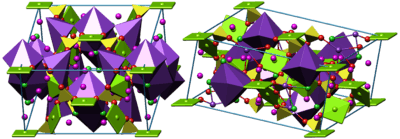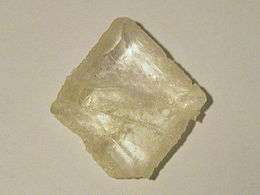Kainite
Kainite (/ˈkaɪnaɪt/ or /ˈkeɪnaɪt/)[4] (KMg(SO4)Cl·3H2O) is an evaporite mineral in the class of "Sulfates (selenates, etc.) with additional anions, with H2O" according to the Nickel–Strunz classification. It is a hydrated potassium-magnesium sulfate-chloride, naturally occurring in irregular granular masses or as crystalline coatings in cavities or fissures. This mineral is dull and soft, and is colored white, yellowish, grey, reddish, or blue to violet. Its name is derived from Greek καινος [kainos] ("(hitherto) unknown"), as it was the first mineral discovered that contained both sulfate and chloride as anions. Kainite forms monoclinic crystals.

| Kainite | |
|---|---|
 | |
| General | |
| Category | Sulfate minerals |
| Formula (repeating unit) | KMg(SO4)Cl·3H2O |
| Strunz classification | 7.DF.10 |
| Crystal system | Monoclinic |
| Crystal class | Prismatic (2/m) (same H-M symbol) |
| Space group | C2/m |
| Unit cell | a = 19.72, b = 16.23 c = 9.53 [Å]; β = 94.92°; Z = 16 |
| Identification | |
| Color | Colorless; yellow, brownish, greyish-green, red, violet, blue |
| Crystal habit | Crystal aggregates, fibrous, massive |
| Cleavage | {001}, perfect |
| Fracture | Splintery |
| Tenacity | Brittle |
| Mohs scale hardness | 2.5-3 |
| Luster | Vitreous |
| Streak | White |
| Diaphaneity | Transparent |
| Specific gravity | 2.15 |
| Optical properties | Biaxial (-) |
| Refractive index | nα = 1.494 nβ = 1.505 nγ = 1.516 |
| Birefringence | δ = 0.022 |
| Pleochroism | Visible: X = violet, Y = blue, Z = yellowish |
| 2V angle | Measured: 90° |
| Dispersion | Weak |
| References | [1][2][3] |
Properties
Kainite is of bitter taste and soluble in water. On recrystallization picromerite is deposited from the solution.
Genesis and occurrence
Kainite was discovered in the Stassfurt salt mines in today's Saxony-Anhalt, Germany in 1865 by the mine official Schöne and was first described by Carl Friedrich Jacob Zincken.[5][6]
Kainite is a typical secondary mineral that forms through metamorphosis in marine deposits of potassium carbonate, and is also occasionally formed through resublimation from volcanic vapours. It is often accompanied by anhydrite, carnallite, halite, and kieserite.
Kainite is only found in comparatively few places,[7] among them in salt mines in central and northern Germany, Bad Ischl (Austria), on Pasquasia in Sicily, in Whitby (UK), and in the Carlsbad Potash District in New Mexico, in volcanic deposits in Kamchatka[8] and in Iceland,[9] and in salt lakes in western China. It has also been identified in Gusev Crater on Mars.[10]
Uses
Kainite is used as a source of potassium and magnesium compounds, as a fertilizer, and as gritting salt.
References
- The Handbook of Mineralogy
- Mindat.org
- Webmineral.com
- "kainite". Oxford English Dictionary (3rd ed.). Oxford University Press. September 2005. (Subscription or UK public library membership required.)
- Zincken, C. (1865): Mittheilung an Prof. H.B. Geinitz vom 18.März 1865 [Über ein neues Mineral, Kainit].- Neues Jahrbuch für Mineralogie, Geologie und Paläontologie, 310.
- Zincken, C. (1865): Ueber die Zusammensetzung des Kainits von Leopoldshall bei Stassfurth.- Berg- und hüttenmännische Zeitung 24, 288.
- "Kainite: Localities for Kainite". Mindat.
- Pekov, Igor V., et al. "New zinc and potassium chlorides from fumaroles of the Tolbachik volcano, Kamchatka, Russia: mineral data and crystal chemistry. II. Flinteite, K2ZnCl4." European Journal of Mineralogy (2015): ejm2459_pap_gsw.
- Jacobsson et al (1992) Encrustations from Lava Caves on Surtsey, Iceland. A Preliminary Report: Surtsey Research Progress Report X: 73-78 Reykjevik, Iceland.
- Rice, M. S., et al. "Silica-rich deposits and hydrated minerals at Gusev Crater, Mars: Vis-NIR spectral characterization and regional mapping." Icarus 205.2 (2010): 375-395.